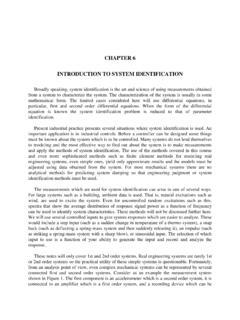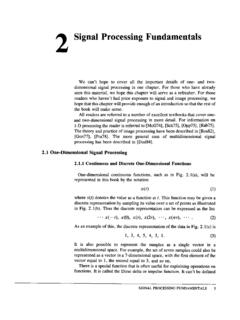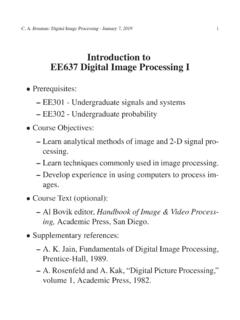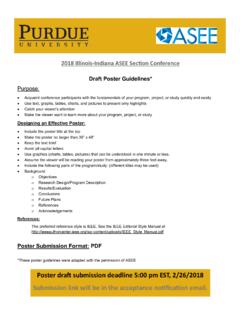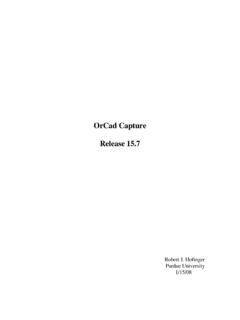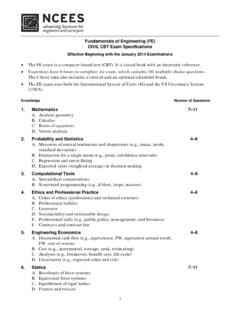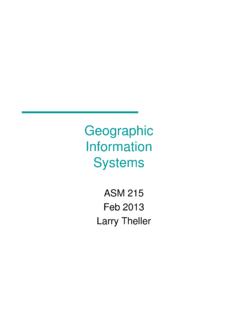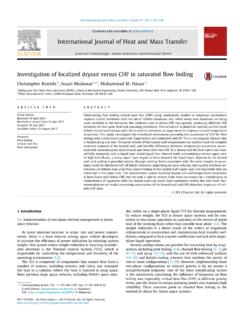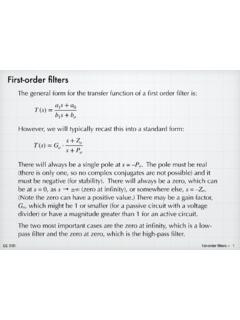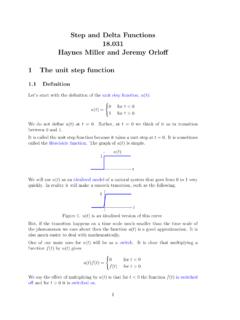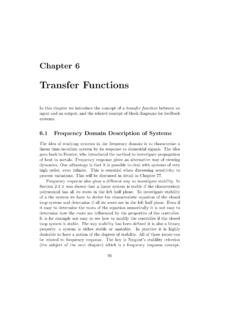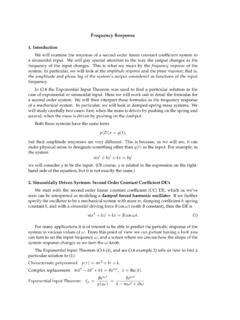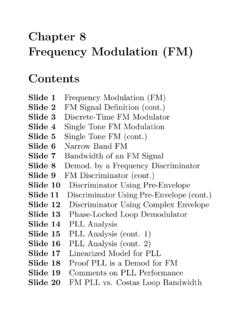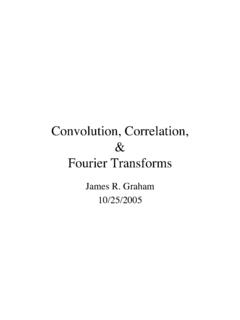Transcription of ECE 380: Control Systems - Purdue University College of ...
1 ECE 380: Control SystemsCourse Notes: Winter 2014 Prof. Shreyas SundaramDepartment of Electrical and Computer EngineeringUniversity of Waterlooiic Shreyas SundaramAcknowledgmentsParts of these course notes are loosely based on lecture notes by ProfessorsDaniel Liberzon, Sean Meyn, and Mark Spong ( University of Illinois), on notesby Professors Daniel Davison and Daniel Miller ( University of Waterloo), andon parts of the textbookFeedback Control of Dynamic Systems (5th edition) byFranklin, Powell and Emami-Naeini.
2 I claim credit for all typos and mistakesin the LATEX template forThe Not So Short Introduction to LATEX 2 by T. Oetikeret al. was used to typeset portions of these SundaramUniversity of Waterlooc Shreyas Sundaramivc Shreyas SundaramContents1 Dynamical Systems .. What is Control Theory? .. Outline of the Course ..42 Review of Complex Numbers53 Review of Laplace The Laplace Transform .. The Inverse Laplace Transform .. Fraction Expansion .. The Final Value Theorem.
3 154 Linear Time-Invariant Linearity, Time-Invariance and Causality .. Transfer Functions .. the transfer function of a differential equationmodel .. Frequency response .. 215 Bode Rules for Drawing Bode Plots .. Plot forKo.. Plot forsq.. Plot for (sp+ 1) 1and (sz+ 1) .. 29c Shreyas Plot for((s n)2+ 2 (s n) + 1) 1.. Phase Systems .. 346 Modeling and Block Diagram Mathematical Models of Physical Systems .. Systems .
4 Systems .. Systems .. Block Diagram Manipulation .. with Multiple Inputs and Outputs .. 457 Step Responses of Linear Step response of First Order Systems .. time .. time .. Step response of Second Order Systems .. and Critically Damped Systems (0 1) System ( >1) .. 528 Performance of Second Order Step Performance Measures .. time (tr) .. value (Mp), Peak time (tp) and OvershootOS.. Time (ts).
5 Choosing Pole Locations to Meet Performance Specifications .. Effects of Poles and Zeros on the Step response .. of a Zero on the Step response .. of Poles on the Step response .. 639 Stability of Linear Time-Invariant Pole-zero cancellations and stability .. Stability of the Unity Feedback Loop .. Tests for Stability .. 68c Shreyas Necessary Condition for Stability .. Necessary and Sufficient Condition: Routh-Hurwitz Test For Degree of Stability.
6 Parametric Stability with Routh-Hurwitz .. 7310 Properties of Feedforward Control .. Feedback Control .. 7711 Tracking of Reference Tracking and Steady State Error .. 8212 PID Proportional (P) Control .. Proportional-Integral (PI) Control .. Proportional-Integral-Derivative (PID) Control .. Implementation Issues .. 9313 Root The Root Locus Equations .. Phase Condition .. Rules for Plotting the Positive Root Locus.
7 Start Points and (Some) End Points of the Root Locus . Points on the Real Axis .. Asymptotic Behavior of the Root Locus .. Breakaway Points .. Some Root Locus Plots .. Choosing the Gain from the Root Locus .. Rules for Plotting the Negative Root Locus .. 11114 Stability Margins from Bode Plots11515 Compensator Design Using Bode Lead and Lag Compensators .. Lead Compensator Design .. Lag Compensator Design .. 130c Shreyas SundaramviiiCONTENTS16 Nyquist Nyquist Plots.
8 Drawing Nyquist Plots .. Nyquist Plots For Systems With Poles/Zeros On The Imag-inary Axis .. Stability Margins from Nyquist Plots .. 14617 Modern Control Theory: State Space State-Space Models .. Nonlinear State-Space Models and Linearization .. Linearization via Taylor Series .. The Transfer Function of a Linear State-Space Model .. Obtaining the Poles from the State-Space Model .. An Overview of Design Approaches for State-Space Models .. 162c Shreyas SundaramChapter Dynamical SystemsFor the purposes of this course, asystemis an abstract object that acceptsinputsand producesoutputsin response .
9 Systems are often composed of smaller com-ponents that are interconnected together, leading to behavior that is more thanjust the sum of its parts. In the Control literature, Systems are also commonlyreferred to : An abstract representation of a termdynamical systemloosely refers to any system that has an internalstate and some dynamics ( , a rule specifying how the state evolves in time).This description applies to a very large class of Systems , from automobiles andaviation to industrial manufacturing plants and the electrical power grid.
10 Thepresence of dynamics implies that the behavior of the system cannot be en-tirely arbitrary; the temporal behavior of the system s state and outputs can bepredicted to some extent by an appropriatemodelof the a simple model of a car in motion. Let the speed ofthe car at any timetbe given byv(t). One of the inputs to the system is theaccelerationa(t), applied by the throttle. From basic physics, the evolution ofthe speed is given bydvdt=a(t).( )The quantityv(t) is the state of the system, and equation ( ) specifies thedynamics.
